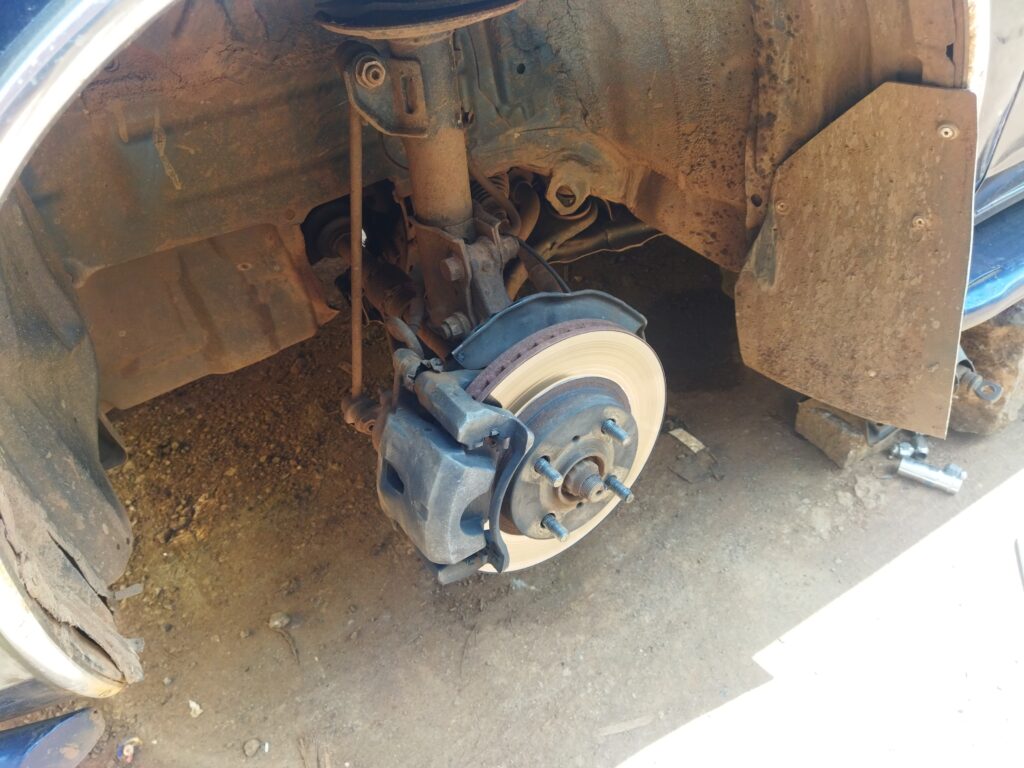Did you know that you can stop your car from 100 kilometers per hour faster than a cheetah can reach that speed? And It’s all thanks to the brakes. Therefore, keeping your brakes in top shape is crucial, especially in Kenya, where busy roads and unexpected hazards demand quick reactions. Which brake brake configurations achieve the best braking performance? Why do manufacturers use different brake configurations?
But not all cars stop the same way. Some have modern disc brakes, others have old-school drum brakes, and others have a combination of both.
Why the different setups? Read on to learn more about brake configurations and what they mean for your car.

Imagine a spinning bicycle wheel. Now, picture yourself squeezing the rim between your fingers to slow it down. That’s basically how disc brakes work.
A disc brake system has three main components:
When you press the brake pedal, the fluid squeezes the caliper. This forces the brake pads to grip the spinning rotor, creating friction and slowing down your car.
Pros
Cons
The main disadvantage of disc brakes is their cost. Their components and replacement are costlier than drum brakes.
While disc brakes are the flashy newcomers, drum brakes are the seasoned veterans. Think of them as a hidden drum inside the wheels of your car.
Here are the key components of a drum brake system:
When you step on the brake pedal, brake fluid forces the wheel cylinder to push the brake shoes against the rotating brake drum. The resulting friction slows down your car.
Pros
Cons
Maintenance issues: Drum brakes are relatively more complicated to inspect and service compared to disc brakes.
Picture a powerful athlete with the perfect running shoes. That’s the idea behind the mixed brake configurations: disk brakes for the front wheels and drum brakes for the rear wheels. The mixed configuration strikes a balance between performance and keeping costs down.
Automakers know that putting high-performance disc brakes on every wheel would drive the cost of cars high. By putting drum brakes in the rear wheels, they offer budget-conscious vehicles.
The mixed brake configurations also makes sense because most of the braking heavy-lifting happens in the front. When you hit the brakes hard, most of the force shifts to the car’s front. As mentioned before, disc brakes have superior stopping power. The drum brakes on the back wheels can adequately handle the lighter braking tasks.
Most budget-conscious cars in Kenya have a mixed configuration, which makes sense because it balances stopping power and affordability in an economy where car maintenance costs are a significant factor.
Some of the popular cars on Kenyan roads with this mixed setup include:
There are times when the disc-drum brakes combo just won’t cut it. Here is where you are likely to find disc brakes on all wheels:
Popular vehicles on Kenyan roads with all-around disc brakes include:
Remember: Car features vary across model years and trim levels. Always do your due diligence and verify the brake setup for the specific vehicle you have in mind.
Regardless of the brake setup in your car, it is very important to keep your brakes in top shape. Here is what you should keep in mind:
Knowing how your car’s brake setup works empowers you to make informed decisions about maintenance and spot potential problems early. To recap, disc brakes offer superior stopping power and remain effective regardless of weather. Drum brakes are cost-effective and work well for handbrakes. A mixed setup strikes a balance between performance and affordability.
Need help with your car’s braking system? Whether you need a routine inspection, expert advice, or quality brake parts, our team at Varsani Brake Linings is ready to help. Contact us today and let our experts give you the peace of mind you need behind the wheel.
WhatsApp us